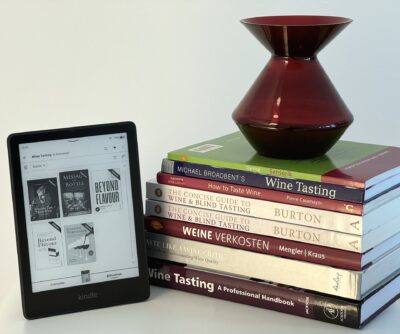Wine tasting books – My top 3
 More and more books have been published recently on the subject of wine tasting. In my opinion, only a few of them are worth reading; some books do not cover the subject in the best possible way or are too superficial. Here are my top 3 books on the subject of wine tasting to make your choice a little easier:
More and more books have been published recently on the subject of wine tasting. In my opinion, only a few of them are worth reading; some books do not cover the subject in the best possible way or are too superficial. Here are my top 3 books on the subject of wine tasting to make your choice a little easier:
1st place
For me, Neil Burton’s book – The Concise Guide to Wine & Blind Tasting – is the undisputed leader. It is already in its 2nd edition and is designed to help WSET Diploma students, MW students, Master Sommelier students to become better wine tasters. The techniques of wine tasting are explained very clearly and in detail. It gives very good guidance and assistance, also includes other wine tasting techniques such as Beyond Flavour. The book contains many illustrative examples of tasting notes and explains well how and why they were created in this way.
Neil Burton also gives an excellent overview of the winemaking process and the wine regions of the world. He explains the styles and characteristics of wines from different wine regions. It is not only a wine tasting book, but also a good recap of the wine regions and their characteristics. It is therefore an excellent preparation for the WSET Diploma D3 “Wines of the World” exam.
2nd place
Anyone Can Taste Wine by Cees van Casteren MW, takes a different approach and focuses entirely on tasting techniques. The good graphic elements lighten up the book and illustrate the techniques described very clearly. This makes it easier to memorise the knowledge and therefore leads to better learning success.
Van Cees has developed a different wine tasting scheme, which he calls the Character Method (colour, harvest aromas, vinification aromas, ripening aromas, acidity, candy (sugar content), tannins, ethanol (alcohol) and relative fruit intensity), which differs significantly from the WSET SAT. I find this deviation particularly exciting, as it reveals new aspects that are very helpful on the way to better deciphering the wine. He explains all the factors that influence a wine and offers many useful and helpful tips that can help you to describe the wine better and to draw the right conclusions from the objective description of the wine without bias. The book is not necessarily aimed at WSET Diploma students or Master of Wine students, it is more a book for people who want to start their WSET courses and want to find a deeper approach to the subject.
3rd place
Although Message in the Bottle: A Guide for Tasting Wine by Tim Gaiser is based on the Court of Master Sommelier’s deductive tasting technique, it is very useful for the WSET Diploma. Tim Gaiser explains each category of the Court of Master Sommelier’s deductive tasting process in detail and gives many practical tips. He also explains how to write better tasting notes and how to recognise patterns in wines better and faster. He describes how to train your olfactory and gustatory memory. In addition, we learn how important the technical data sheets of individual wines can be for tasting, because a well-done and thought-out technical data sheet contains many aspects that we want to decipher when tasting wine, such as the sugar content or the pH value of the wine.
Tim Gaiser manages to convey the subject of wine tasting in a practical and theoretical way that is both clear and entertaining for professionals and beginners.
